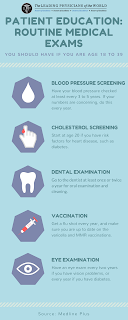Patient Education
New
nurses know that teaching patients is important. They also know that their
shifts are usually so hectic that patient teaching comes after more immediate
responsibilities, such as medicication administration and dressing changes. New
nurses need to get in the habit of thinking about patient education as a way of
providing nursing care beyond the here and now. Even more important, new nurses
need to maximize the time they spend on patient education to obtain the best
outcomes for their patients. Busy nurses often find it difficult to provide
effective patient teaching in the current healthcare climate. As Fran London, a
nurse, patient-education expert, and author, noted, “Teaching patients isn't
rocket science, but it is a sophisticated skill that takes practice and
commitment. Without patient education, there's very little effective healthcare
with improved long-term outcomes”.
When nurses
incorporate patient education into the patient's plan of care, they can improve
their teaching effectiveness and increase the likelihood of optimal patient
outcomes. Many excellent resources describe tools and techniques nurses
can use in patient education. Yet it can be difficult for nurses to sort
through the forest of available resources when they're needed at a moment's
notice. Nurses are often required to think on their feet when teaching patients
under less-than-ideal situations.
Patient teaching techniques
PatEdNet,
StaffEdNet, and PIPELine are electronic mailing lists that let healthcare
educators share and discuss patient- and staff-education issues. The overall
goal of these three noncommercial lists is to improve professional practice as
participants learn from each other. To add to the best patient-education
practices discussed in this article, the authors asked subscribers to the three
lists to share effective patient-education strategies they've used. (In the
request, subscribers were informed their ideas would be used in an article to
be submitted to a nursing journal on best patient-education techniques.)
By far the
most effective patient-education strategy mentioned was to assess the patient
and adjust teaching to these needs. For patient teaching to be effective,
nurses must know their patients and individualize patient education. Busy nurses
may think time allows them to give patients only printed materials. But as
important as these materials are, they're only a small part of the
individualized patient-education process.
Find out
what motivates each patient. What's important to him or her? Motivational
interviewing can help make your teaching more effective. One idea is to let the
patient choose the topic of most interest, and then address that area first.
Another question to ask the patient is, “What's important for you to learn?”
Based on
the assessment of patient learning needs and styles, the education provided
should use common words, readable materials (written around the sixth grade
reading level), and various teaching techniques based on learning styles. For
example, does the patient prefer viewing audiovisual materials, watching
demonstrations, listening to instructions, or reading printed materials? It
boils down to “involve, individualize, assess, and evaluate understanding.”




Comments
Post a Comment